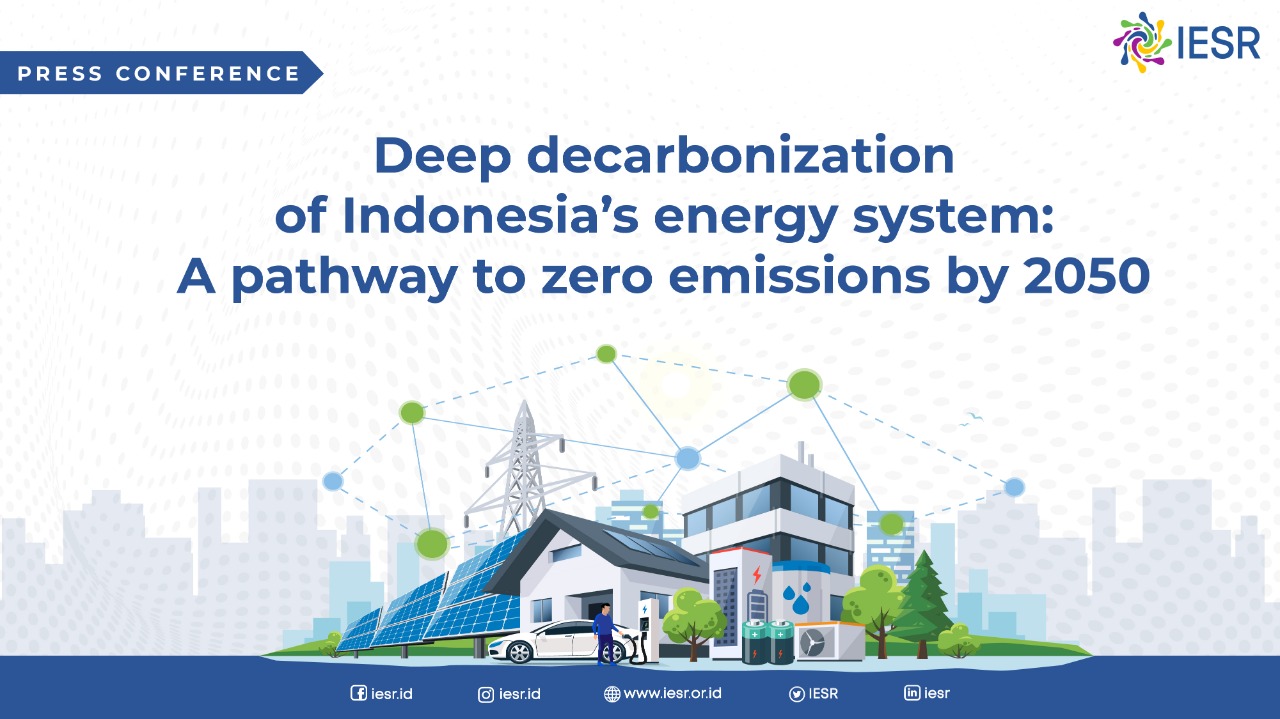A pathway to zero emissions by 2050: Technologically and Economically Feasible, Indonesia Just Needs a Strong Political Will and Bold Plan to Reach Zero Emissions by 2050
The narrow time is running out to overcome the increasingly threatening climate crisis. In contrast, Indonesia’s NDC is lacking ambition in complying with the Paris Agreement to keep the earth’s temperature below 2 degrees, let alone the 1.5 degrees Celsius. It was evident in the 2050 Long-term Strategy on Low Carbon and Climate Resilience (LTS-LCCR) document in mitigating climate change which only targets carbon neutrality in 2070.
Institute for Essential Services Reform (IESR) new report “Deep decarbonization of Indonesia’s energy system: A pathway to zero emissions by 2050” shows that Indonesia’s energy sector is technologically and economically feasible to achieve zero carbon emissions by 2050.
This report is the first comprehensive study in Indonesia to present a path to achieving a zero emission energy sector by 2050. It is an important milestone as the current mitigation action in the energy sector is not ambitious enough. The emissions from the energy sector are predicted to increase to 58% by 2030, as indicated under the BAU scenario in Indonesia’s Nationally Determined Contribution (NDC), mainly driven by the increase in the final energy consumption.
“As one of the largest economies in the world and with its strategic position in Southeast Asia, Indonesia should take a lead in transforming its energy system now. Decarbonization of Indonesia’s energy system could bring significant impacts on the region and inspire other countries to accelerate energy transition. Making this happen will require strong political commitment and leadership by President Jokowi,” said Fabby Tumiwa, Executive Director of IESR.
He added that the first and crucial step of this journey is to reach an emission peak by 2030 at the latest. With strong policy support, renewable energy shall be deployed at large scale, accompanied by declining thermal power capacities.
Using the Energy System Transition Model developed by the Lappeenranta University of Technology (LUT), this report shows that it is achievable to use 100 percent of renewable energy in the power, heat, and transport sectors in Indonesia.
“The model used for the detailed scenario analyses for Indonesia is designed for hourly temporal resolution and interconnected regions, as this is of highest relevance for the energy transition of Indonesia for ensuring a stable energy supply for all hours and all regions,” said Christian Breyer, LUT Solar Economy Professor.
This decade will become a crucial time for decarbonization efforts in Indonesia. To bend the emission curve, Indonesia needs to install around 140 GW of renewable energy by 2030, of which about 80% is solar PV. Sales of electric cars and motorcycles should increase to 2.9 million and 94.5 million by 2030 respectively, a dramatic increase from nearly zero sales today. Meanwhile, electric heating should become the main heat producer in the industrial sector, accompanied by biomass energy. Most importantly, PLN needs to stop building new coal-fired power plants by 2025.
By 2045, renewable energy supplies 100 percent of the electricity in Indonesia. For the first time, the Indonesian power sector becomes carbon free. Solar PV is the largest contributor in power generation with 88% share, followed by hydropower at 6%, geothermal at 5%, and other renewable energy at 1%. To address the intermittency issue, energy storage technology is used, mainly batteries. Meanwhile, synthetic fuels, hydrogen, and electric heating will play a greater role in decarbonizing the transport and industry sectors. The importance of grid integration of Java, Sumatra, Kalimantan, and other islands will increase from 2030 onwards as renewable energy becomes the backbone of Indonesia’s energy system. The IESR model shows that by 2050, an overall transmission capacity of 158 GW is required to connect the archipelago from west to east.
By continuing the decarbonization efforts in the much-harder-to-abate transport and industry sectors to 2050, Indonesia will reach a point where the whole energy sector becomes carbon free through the use of 100% renewable energy. The decarbonized energy system would potentially reduce the annual system cost by 20% compared to a fossil-based energy system.
To reach such an ambitious target, Indonesia will need investment of USD 20-25 billion per year from now until 2030 and will increase to USD 60 billion per year between 2030 and 2040. Considering the big investment needs, the government should attract investment from the private sector and individuals. Improvement of the investment climate is therefore crucial in this endeavor.
“The size of the challenge should not obscure the fact that deep decarbonization will bring enormous benefits and opportunities to Indonesia’s economy,” said Pamela Simamora, Research Coordinator of IESR and author of this report.
Through deep decarbonization, Indonesia will see at least 3.2 millions of new, sustainable and quality jobs, the improvement of public health (which will also imply a substantial reduction in health costs), and the establishment of a modern economy, which enable the country to compete in the growing world market for carbon-neutral products. To get there, a strong political will is required. The Indonesian government also needs to put in place the right policies and regulations today and remove regulations and policies perceived as barriers to clean technology investments.
The report “Deep decarbonization of Indonesia’s energy system: A pathway to zero emissions by 2050” is a study by IESR in collaboration with Agora Energiewende, and Lappeenranta University of Technology (LUT). The launch of the report is held on May 28th, 2021. The report can be downloaded at the following link:

